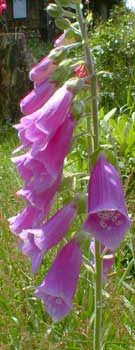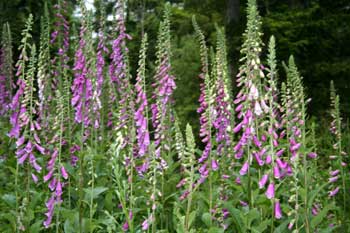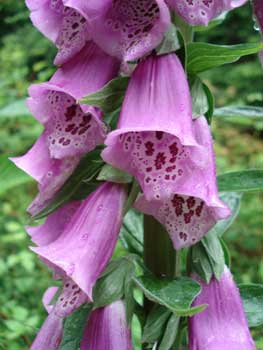
Common Foxglove
"My poor Babe
Was crying, as I thought, crying for bread
When I had none to give him; whereupon,
I put a slip of foxglove in his hand,
Which pleased him so, that he was hushed at once:
When, into one of those same spotted bells
A bee came darting, which the Child with joy
Imprisoned there, & held it to his ear,
And suddenly grew black, as he would die."
-William Wordsworth
(1770-1850)
(1770-1850)
Foxglove (Digitalis purpurea) has naturalized throughout our county here on Puget Sound. Some of them may have originated from the intentional seeding of wildflowers; mostly they got themselves everywhere they could as garden escapees.
It is one of the commonest non-native wildflowers along highways & freeway margins & woodland edges & forest clearings. In June when they are in full flower we see them everwhere, in & out of gardens.
The first June photo shows one of these foxgloves growing down the block near the Garden of Paghat the Ratgirl, on the road's edge. The second photo shows the woodland edge near friends' gardens. The third photo taken in June of another year was just on the roadside nearby.
 These are biennials which for their first year produce large furry basal leaves easily mistaken for comfrey. For their second year they send up their enormous spikes, up to seven feet tall in the Northwest, in most places only three to five feet. They die after seeding. If the flowers are taken for bouquets before going to seed, the basal leaves will last another year to attempt to seed again.
These are biennials which for their first year produce large furry basal leaves easily mistaken for comfrey. For their second year they send up their enormous spikes, up to seven feet tall in the Northwest, in most places only three to five feet. They die after seeding. If the flowers are taken for bouquets before going to seed, the basal leaves will last another year to attempt to seed again.One sees three basic color phases self-seeded throughout the county: white, pink, & purple. They can seed true to the parent wherever color forms are isolated, but they cross-pollinate freely & most stands of foxgloves include all shades.
Originally native to Europe, they are now found at all quarters of North America. They like most any soil conditions & can even grow in rocky crevices with hardly any soil at all.
Foxglove is the source of several cardiac glycosides, the very digitalis used as a heart medication. With careful usage with physician guidance, digitalis has saved thousands of lives, but it is at the same time a dangerously toxic plant. It can cause heart palpitations, delerium, hallucinations, vomiting, & possibly death.
 Plants that are widespread & medicinally potent invariably acquire a large number of folk-names, & foxglove's many names are a case study in peasant imagination.
Plants that are widespread & medicinally potent invariably acquire a large number of folk-names, & foxglove's many names are a case study in peasant imagination.The name Foxglove is from an old fairy-belief that foxes were taught by the fairies to wear the bell-flowers on their feet to soften their tread as they sneak into henhouses or slip away from fox hunters. The recurring association with foxes lent it the additional names Dog's Lugs, Dog's Fingers, Fox's Lugs, Fox-&-Leaves, Foxdock, Foxter, Foxies & Foxbell. Possibly even the name Bunch of Grapes alluded to the fable of the Fox & the Grapes.
The large furry leaves were thought to be like the fur of a fox, but some imagined not a fox but a rabbit, hence the names Bunny Rabbits or Rabbit Mouth, & names that incorporate the name "flops" means the ears, as in Bunny Flops or Foxflops.
The sentiment that the flowers resemble the fingers of gloves lent them names like Dog's Fingers, Fingerhuts, & Fingerflowers. Due to their toxicity, they are Dead Man's Bells, Dead Men's Fingers, Deadmen's Thimbles, Dead Man's Bellows, Bloody Fingers, Bloodybells, & Bloody Man's Fingers.
An association with midwifery probably gave rise to the names Granny's Gloves or Granny's Bonnets, & Witch's or Witches' Gloves. Witches & grannies, or at least midwives & other herbal practitioners, had many uses for this plant. Dr William Withering, the man credited with discovering digitalis as a heart remedy circa 1775, actually learned of its potency from an unnamed midwife.
Fairies were believed to wear the flower-thimbles on their fingers while working their magic, & to wear them as hats or petticoats, inducing poet Hartley Coleridge (1796-1849) to write:
"Were we like the FaysSuch belief is reflected in the names Fairy Caps, Fairy Gloves, Fairy Thimbles, Fairy Herb, Fairybells, Fairy-fingers, Goblin Gloves, Fairy Petticoats, Fairyweed, or Folks' Gloves, the fairies being sometimes called merely Folks since to speak of them explicitely was believed to get their attention & cause them to do mischief. In Gaelic they were Lus Mor, the Great Herb, for being the most magical of all herbs.
That sweetly nestle in the foxglove bell."
At the same time, because of their healing properties, they are Virgin's Gloves or Gloves of Our Lady, sacred to the Virgin Mary. The names Lady's Fingers, Lady's Gloves, Lady's Slipper, or Lady's Thimbles do not mean any mortal ladies, but the Divine Lady, & undoubtedly had this association with the Great Mother long before Mary reached Europe.
Foxglove mythology associates the flower with Juno (Hera) who learned midwife lore from the Goddess Flora, including a supernatural method of using foxgloves to induce parthenogenetic pregnancy. Flora placed a foxglove blossom on her thumb, touched Juno on the tips of her breasts & on her belly, so that she became impregnated with Mars who had no father.
Foxglove flowers were also supposed to look like an animal's open mouth. Within the doctrine of signatures this meant it must have some medicinal value in treatment of injuries of the mouth & throat. The speckles in the mouth of the flower were according to the Doctrine symbolic of inflamation of the throat. An array of folk-names reflect foxglove's association with the mouth: Throatwort, Rabbit's Mouth, Bunny Mouths, Tiger's Mouth, Duck's Mouth, Gap-Mouth, & Dragon's Mouth.
The name Dragon's Mouth echoed that of the Snapdragon (Antirrhinum magus), & foxgloves were also sometimes called Snapdragons, Snaps, or Snaphacks. In Glaucestershire they were called Snoxun or Snauper.
They were Scotch Mercury, because foxgloves were symbolic of Clan Farquharson, & as a medicinal plant it was used for some of the same things as mercuries (Mercurialis sp), hence also the name Wild Mercuries. The Fighting Farquharsons liked this symbol because foxgloves represented a celestial god's sword dangling from a swordbelt. The folk-name King's Elwand or Ellwand was a very old name for Orion's Belt, about which the Scottish author James Hogg (1770-1835) wrote:
"The kye they lay down by the side of the Weel,The names Flopdock, Floppydock, Flop-a-Dock, Flapdock, Popdock, Flop-poppy, Flop-top, Cowflop, Gooseflops, Rabbit's Flowers or Bunny Rabbits all allude to the large soft furry leaves. Names that allude additionally to poppies was not due to any physical resemblance, but to their similar importance as a medicinal plant relieving pain, hence the names Greenpops or Green Poppies, Hedge Poppy, Pop-dock or Poppy-dock, Pop-ladders, Poppers, & Pop-guns. Recurring allusions to "dock" assumes a similarity of foxglove leaves & the leaves of certain species of rumex or dock.
On the Elibank craig, an' the Ashiesteel bourn;
An' ere the king's elwand came over the hill,
Afore Will an' his men rattled mony a horn."
Some other miscellaneous names are Beecatchers or Beehives, Blobs, Clothes Pegs, Coventry Bells, Herbells, or Long Purples. They were Cottagers because so common in cottage gardens, & they were Scabbit Dock because in Culpepper's day it was used in an ointment or shampoo for treating impetigo or "scabby head."
Second photo © by Chet Braun